AUDI A3 2012 Owner´s Manual
Manufacturer: AUDI, Model Year: 2012, Model line: A3, Model: AUDI A3 2012Pages: 280, PDF Size: 70.11 MB
Page 61 of 280
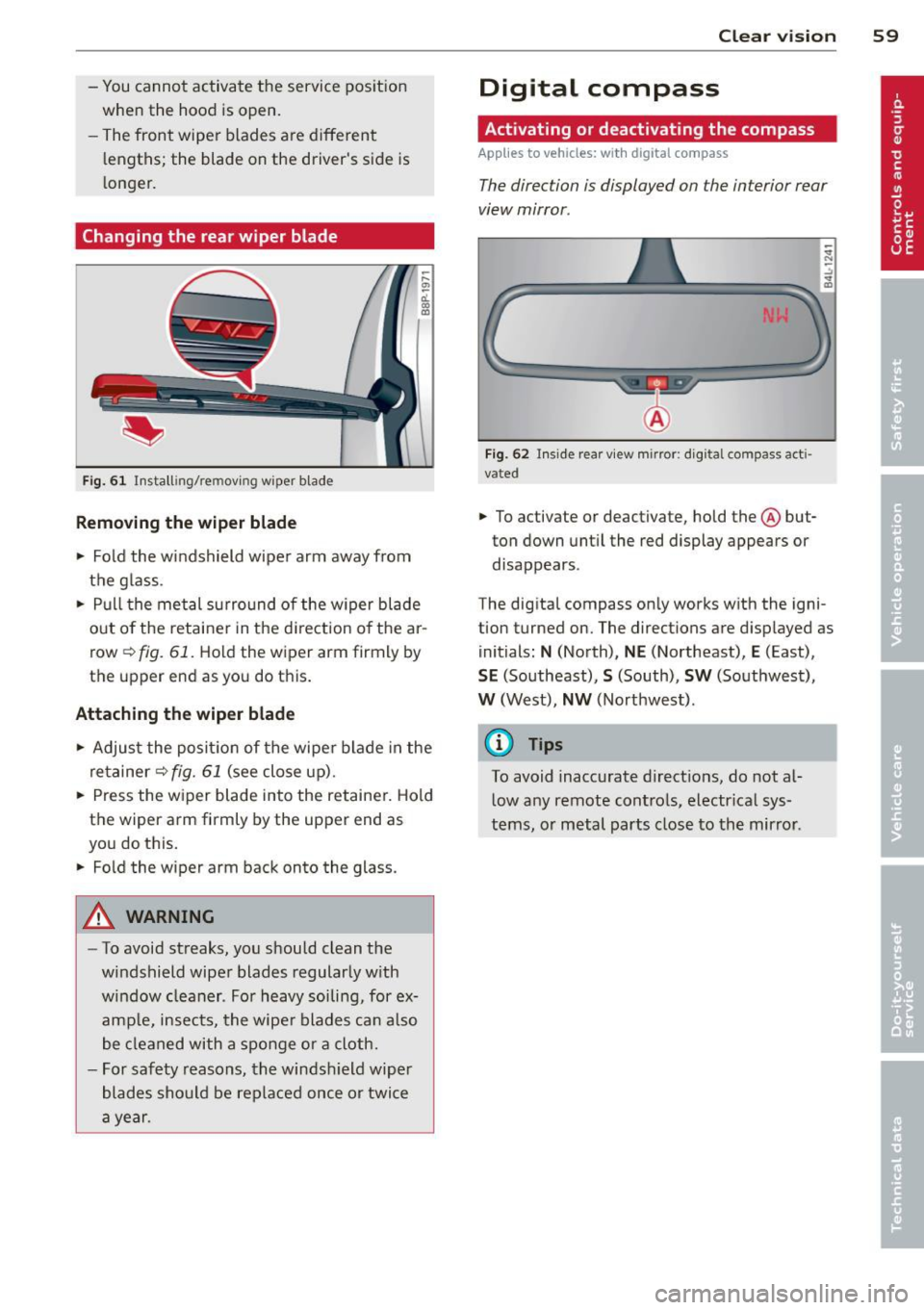
-You cannot activate the service position
when the hood is open.
- The front wiper blades a re different
l engths; the blade on the driver's side is
l onger.
Changing the rear wiper blade
F ig . 6 1 Insta lling/re moving wiper blade
Removing the wiper b lade
.. Fo ld the windshield wipe r arm away from
the g lass .
.. Pull the met al surround of the w iper blade
out o f the retaine r in the d irection o f the ar
row
r=> fig. 61. Hold the wiper arm firmly by
the upper end as you do this.
Attaching the wiper blade
.. Adjus t the posi tion of the wipe r blade in the
retainer
r=> fig. 61 (see close up).
.. Press the w iper blade into the retainer. Hold
t h e wiper arm firmly by the upper end as
you do this .
.. Fo ld the wiper arm back onto the glass.
A WARNING
- To avoid streaks, you should clean the
windshield wiper blades regular ly w ith
w indow cleaner. Fo r heavy soiling, for ex
ample, insects, the wipe r blades can also
be cleaned with a sponge or a cloth.
- For safety reasons, the windsh ield wiper
blades sho uld be replaced once or twice
a year .
Clear vision 59
Digital compass
Activating or deactivating the compass
App lies to vehicles: wi th digi tal co mpass
The direction is displayed on the interior rear
view mirror .
Fig. 62 Inside rear v iew mirror : d ig ita l compass act i
vated
.. To activate or deactivate, hold the@ but
ton down unt il the red display appears or
disappears .
The dig ital compass only works w ith the igni
tion turned on. The directions are displayed as
initials :
N (North), NE (Northeast), E (East),
SE (So utheast), S (South), SW (Southwest),
W (West), NW (Northwest) .
(0 Tips
To avoid inaccurate d irect io ns, do not al
l ow any remote contro ls, electr ica l sys
tems, o r metal parts close to the mir ror.
Page 62 of 280
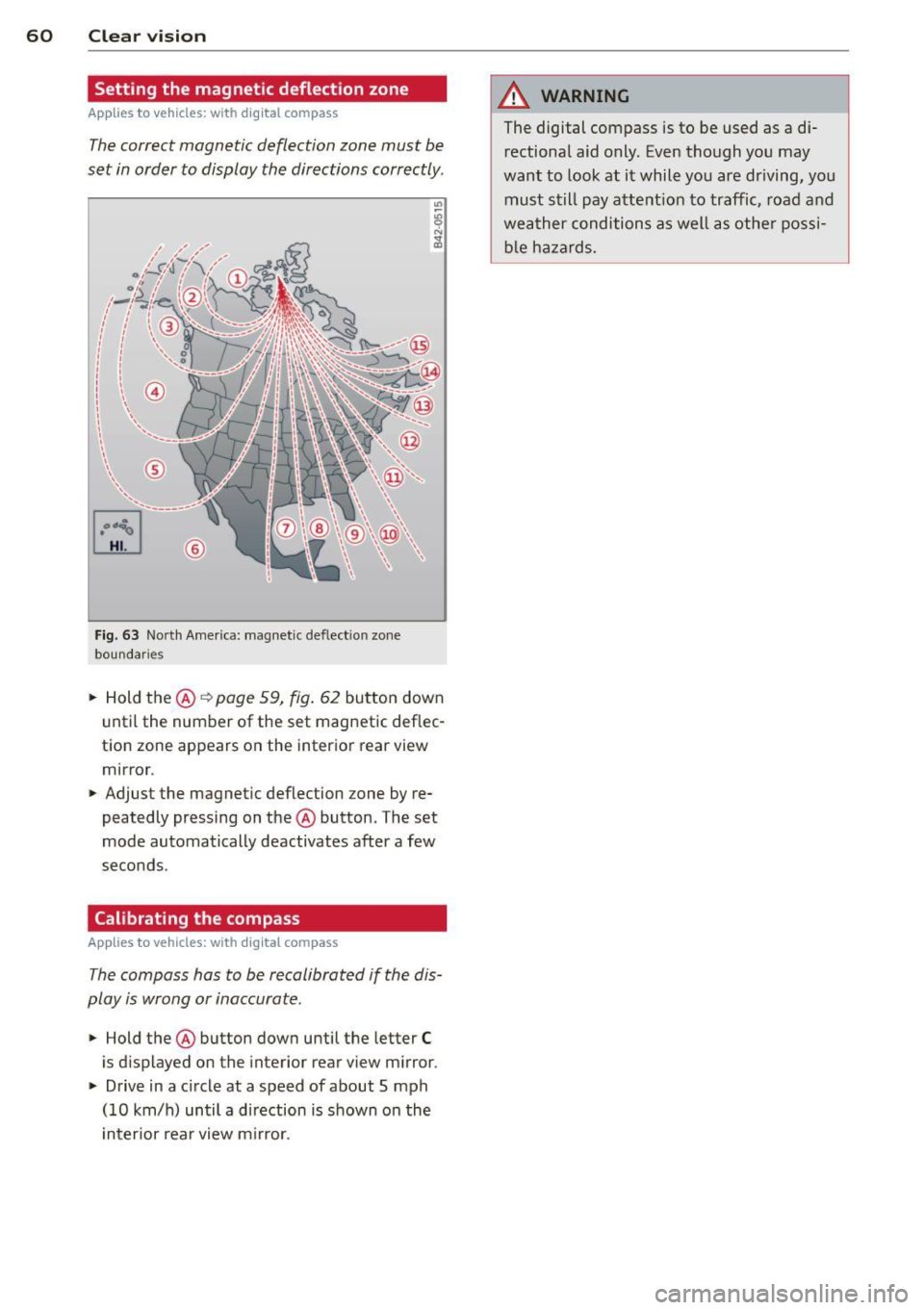
60 Clear vis ion
Setting the magnetic deflection zone
A ppl ies to vehicles: with digital compass
The correct magnetic deflection zone must be
set in order to display the directions correctly.
©
Fig. 63 North America: magnet ic def lect ion zone
boundaries
• Hold the@~ page 59, fig. 62 button down
u ntil the number of the set magnetic deflec
tion zone appears on the interior rear view
mirror .
• Adjust the magnetic deflection zone by re
peatedly pressing on the @button. The set
mode automatically deactivates after a few
seconds .
Calibrating the compass
Applies to vehicles: with digital compass
The compass has to be recalibrated if the dis
play is wrong or inaccurate.
• Hold the@ button down until the letter C
is displayed on the interior rear view m irror .
• Drive in a circle at a speed of about 5 mph
(10 km/h) until a d irection is shown on the
i nterior rear view m irror.
A WARNING
-
The digital compass is to be used as a di-
rectional aid only. Even though you may
want to look at it while you are driving, you
must still pay attent ion to traffic, road and
weather conditions as well as othe r possi
b le ha zards.
Page 63 of 280
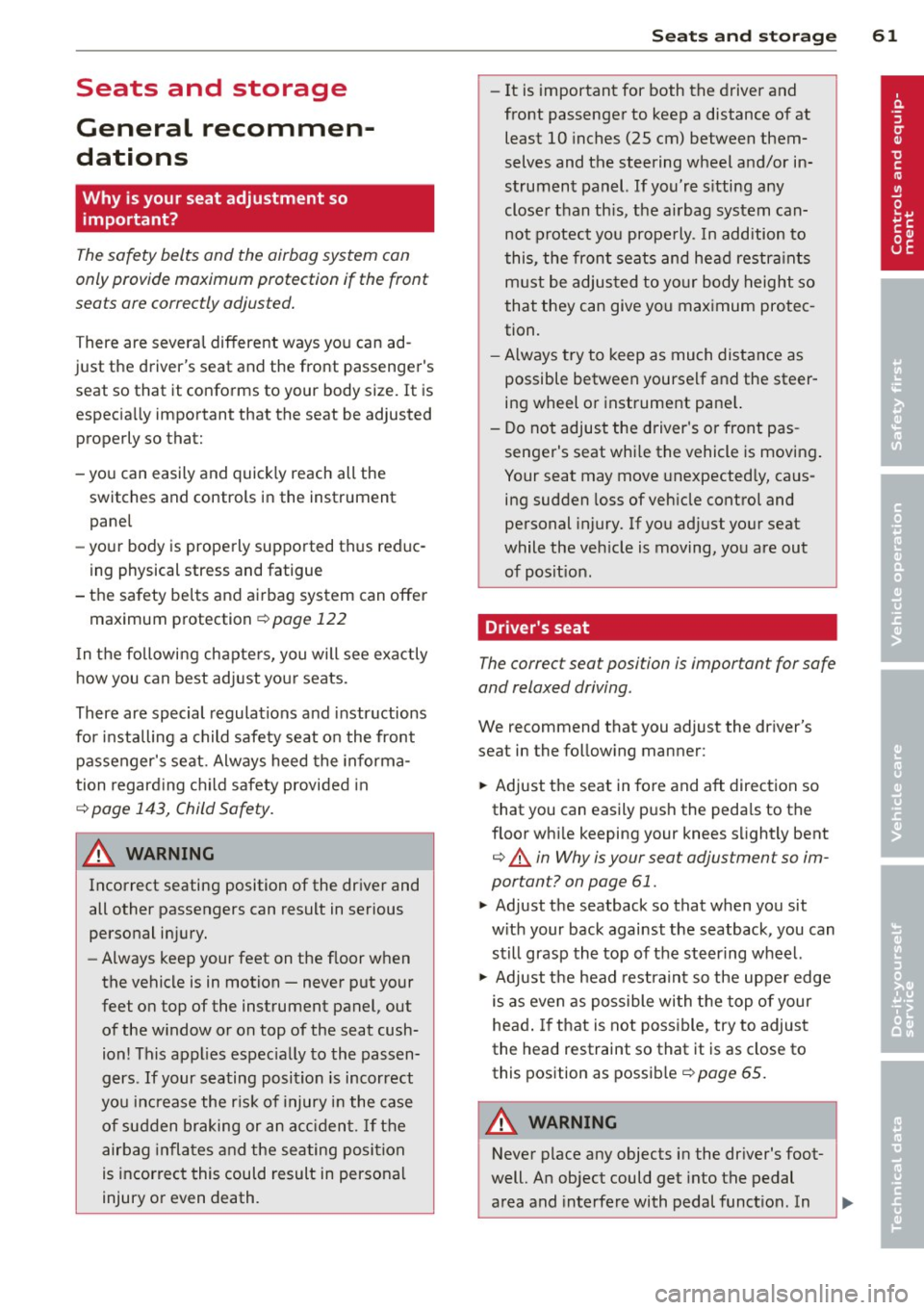
Seats and storage
General recommen
dations
Why is your seat adjustment so important?
The safety belts and the airbag system can
only provide maximum protection if the front
seats are correctly adjusted.
There are several different ways you can ad
just the driver's seat and the front passenger's seat so that it conforms to your body size.
It is
especia lly important that the seat be adjusted
properly so that:
- you can easily and quick ly reach all the
switches and controls in the instrument
panel
- your body is properly supported thus reduc
ing physical stress and fatigue
- the safety belts and airbag system can offer
maximum protection ¢
page 122
In the following chapte rs, you will see exactly
how you can best adjust your seats.
There are special regulations and instructions
for installing a child safety seat on the front passenger's seat. Always heed the informa
tion regard ing child safety provided in
¢ page 143, Child Safety .
A WARNING
Incorrect seating position of the driver and
all other passengers can result in serious
personal injury.
- Always keep your feet on the f loor when
the vehicle is in motion -never put your
feet on top of the instrument panel, out of the w indow or on top of the seat cush
ion! This applies espec ially to the passen
gers.
If your seating position is incorrect
you increase the r isk of injury in the case
of sudden braking or an acc ident. If the
airbag infla tes and the seating posi tion
is incorrect this could result in personal
injury or even death.
S eat s an d sto rage 61
-It is important for both the driver and
front passenger to keep a distance of at
least 10 inches (25 cm) between them
selves and the steering wheel and/or in
strument panel.
If you're s itting any
closer than th is, the airbag system can
not protect you prope rly. In addition to
this, the front seats and head restra ints
m ust be adjusted to yo ur body height so
that they can give you maximum protec
tion.
'
- Always try to keep as much distance as
possible between yourself and the steer
ing wheel or instrument pane l.
- Do not adjust the driver's or front pas
senger's seat whi le the vehicle is moving .
Your seat may move unexpected ly, caus
ing sudden loss of veh icle control and
personal injury. If you adjust your seat
while the veh icle is moving, you are out
of posit ion .
Driver's seat
The correct seat position is important for safe
and relaxed driving .
We recommend that you adjust the driver 's
seat in the fo llow ing manner :
.. Adjust the seat in fo re and aft direction so
that you can easily push the peda ls to the
floor wh ile keeping your knees slight ly bent
¢ .& in Why is your seat adjustment so im
portant? on page 61.
.. Adjust the seatback so that when you sit
w ith your back against the seatback, you can
st ill grasp the top of the steering wheel.
.. Adjust t he head restra int so the upper edge
is as even as possible wi th the top of your
head . If that is not poss ible , try to adjust
the head restraint so that it is as close to
this position as possib le
<=:> page 65.
A WARNING
-Never place any objects in the dr iver's foot-
well. An object could get into the pedal
area and interfere with pedal funct ion. In
Page 64 of 280
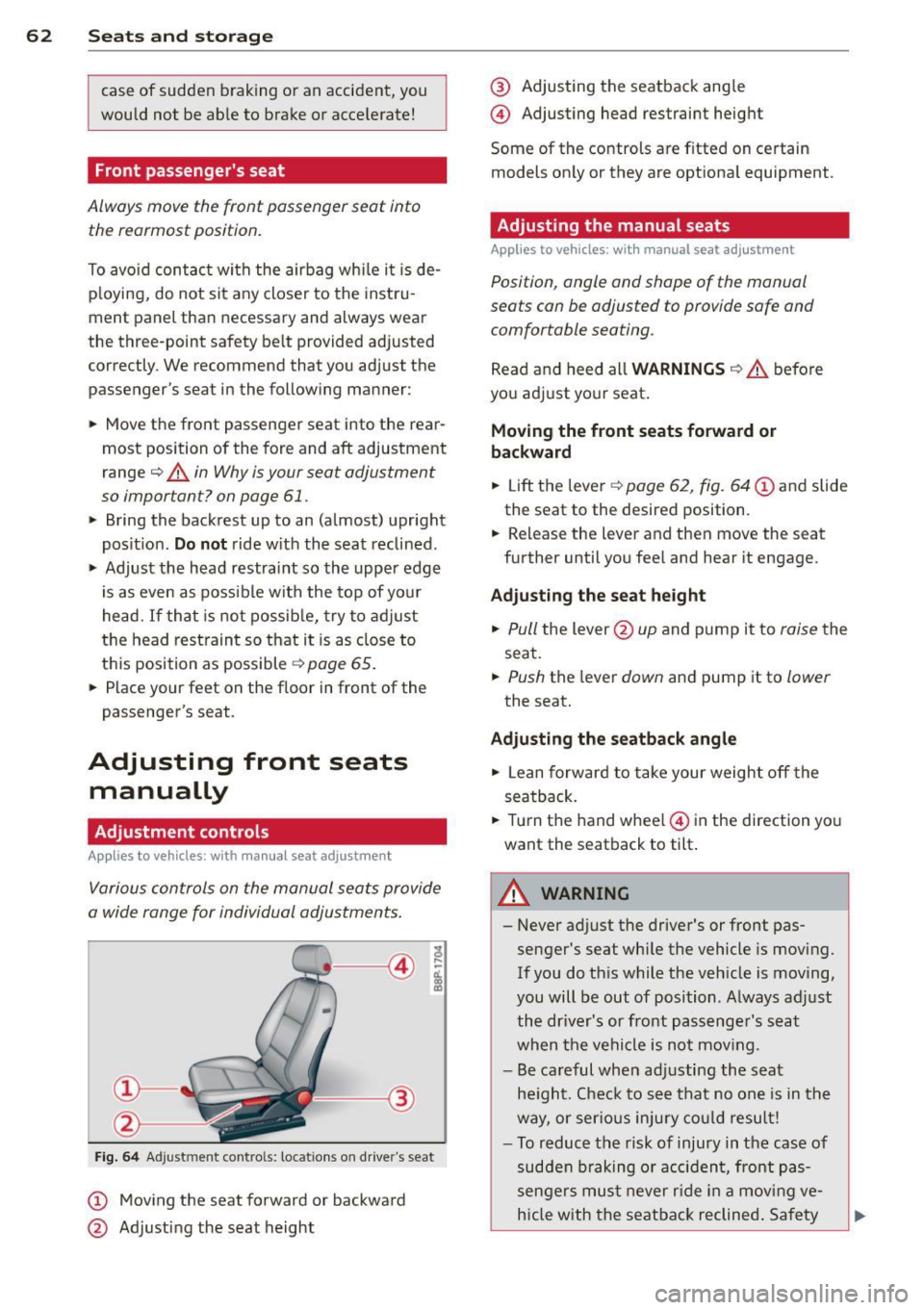
62 Seats and storage
case of sudden braking or an accident, you
would not be ab le to brake or acce lerate!
Front passenger's seat
Always move the front passenger seat into
the rearmost position.
To avo id contact with the airbag wh ile i t is de
p loying, do not sit a ny closer to the inst ru
ment panel than necessary and always wear
the three-point safety be lt provided adjusted
correctly. We recommend that you adjust the passenger's seat in the following manner:
... Move the front passenger seat into the rear
most position of the fore and aft adjustment
range
¢ .&.. in Why is your seat adjustment
so important? on page
61.
... Bring the backrest up to an (almost) upright
pos it ion .
Do not ride w ith the seat reclined.
... Adjust the head restraint so the upper edge
i s as
even as possible with the top of your
head. If that is not possib le, try to adjust
the head rest raint so that it is as close to
t h is position as possible
¢ page 65.
... Place your feet on the f loor in front of the
passenger's seat.
Adjusting front seats manually
Adjustment controls
Applies to vehicles: with manual seat adjustme nt
Various controls on the manual seats provide
a wide range for individual adjus tments.
==""" -®
Fig . 6 4 Ad just ment contro ls: locat ions on drive r"s seat
CD Moving the seat forward or backward
@ Adjusting the seat height
@ Adjusting the seatback ang le
@ Adjusting head restraint height
Some of the co ntrols are fitted on certain
models on ly or they are optiona l equipment.
Adjusting the manual seats
Applies to vehicles: with manual seat adjust ment
Position, angle and shape of the manual
seats can be adjusted to provide safe and
comfortable seating.
Rea d and heed all WARNINGS ¢.&.. befo re
you adjust yo ur seat .
Moving the front seats forward or
backward
"' Lift the leve r¢ page 62, fig. 64 CD and slide
the seat to the desired position .
... Release the lever and then move the seat
further until you feel and hear it engage .
Ad justing the seat height
... Pull the lever @up and pump it to raise the
seat.
... Push the lever down and pump it to lower
the seat.
Adjusting the seatback angle
... Lean forward to take your weight off the
seatback .
... Tur n the hand wheel@ in the di rection yo u
want the seatback to tilt.
A WARNING
- Never adjust the driver's or front pas
senger's seat whi le the vehicle is moving.
If you do th is while the veh icle is moving,
you will be out of position . Always adjust
the dr iver's or front pass enge r's seat
when the vehi cle is not mov ing.
- Be careful when adj usting the seat
he ight. Check to see that no one is in t he
way, or ser io us inju ry co ul d result!
- To reduce the risk of injury in the case of
sudden b raking o r acciden t, front pas
senge rs mus t never r ide in a mov ing
ve
h icle with the seatback reclined . Sa fety
Page 65 of 280
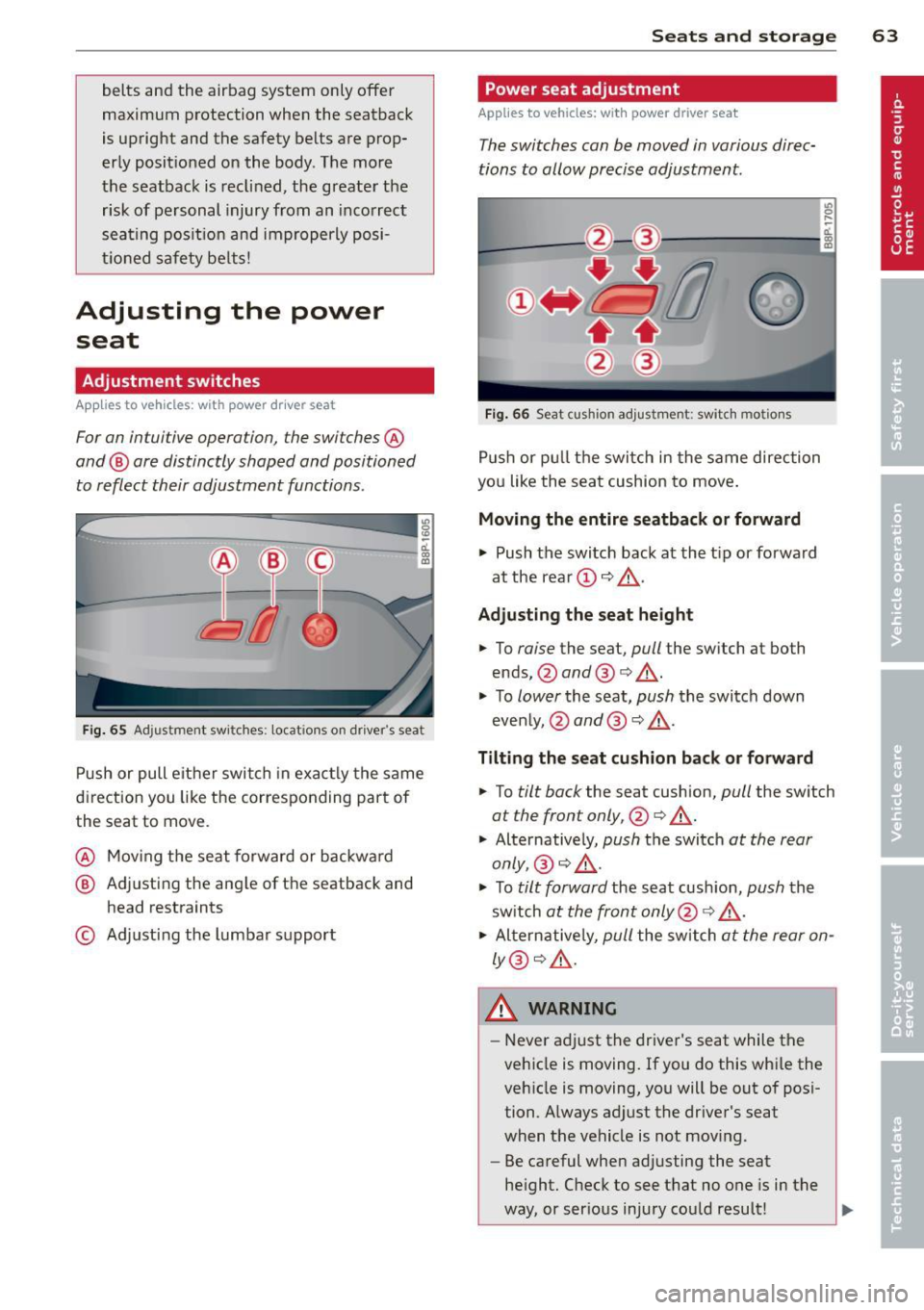
belts and the airbag system only offer
maximum protection when the seatback
is upright and the safety belts are prop
erly positioned on the body . The more
the seatback is reclined, the greater the
risk of personal injury from an incorrect
seating pos it ion and improperly posi
tioned safety belts!
Adjusting the power
seat
Adjustment switches
Ap plies to vehicles: with power driver seat
For an in tuitive operation, the swi tches @
and @ are distinctly shaped and positioned
to reflect their adjustment functions .
Fig. 65 Adjust men t sw it c h es : locat ions on driver 's seat
Push or pull e ither switch in exactly the same
direction you like the corresponding part of
the seat to mov e.
@ Moving the seat forward or backward
@ Adjusting the angle of the seatback and
he ad restraints
© Adjust ing the lumbar support
Seats and storage 63
Power seat adjustment
Applies to vehicles: with power driver seat
The switches can be moved in various direc
tions to allow precise adjustment.
Fig. 66 Sea t cush io n adju stme nt: sw it c h m otions
Push or pull the switch in the same direction
you like the seat cushion to move.
Moving the entire seatback or forward
.,. Push the switch back at the tip or forward
at the rear@c::>
,&..
Adjusting the seat height
.,. To raise the sea t, pull t he switch at both
ends, @
and@ c::> ,&. .
.,. To lower the seat, push the switch down
evenly,
@ and @<=:>,&. .
Tilting the seat cushion back or forward
.,. To tilt ba ck the seat cushion, pull the switch
a t the fron t only, @ c::> ,&. .
.,. Alternatively, push the switch at the rear
only,
@ <=:> ,&. .
.,. To tilt forward the seat cushion, push the
sw itch
at the front only@ Q ,&..
.,. Alternatively, pull the switch at the rear on
ly @
Q ,&. .
A WARNING
-Never adjust the driver's seat while the
vehicle is moving. If you do this whi le the
veh icle is moving, you will be out of posi
tion . Always adjust the driver 's seat
when the vehicle is not mov ing.
- Be careful when adjusting the seat
height. Check to see that no one is in the
way, or serious injury could result!
Page 66 of 280
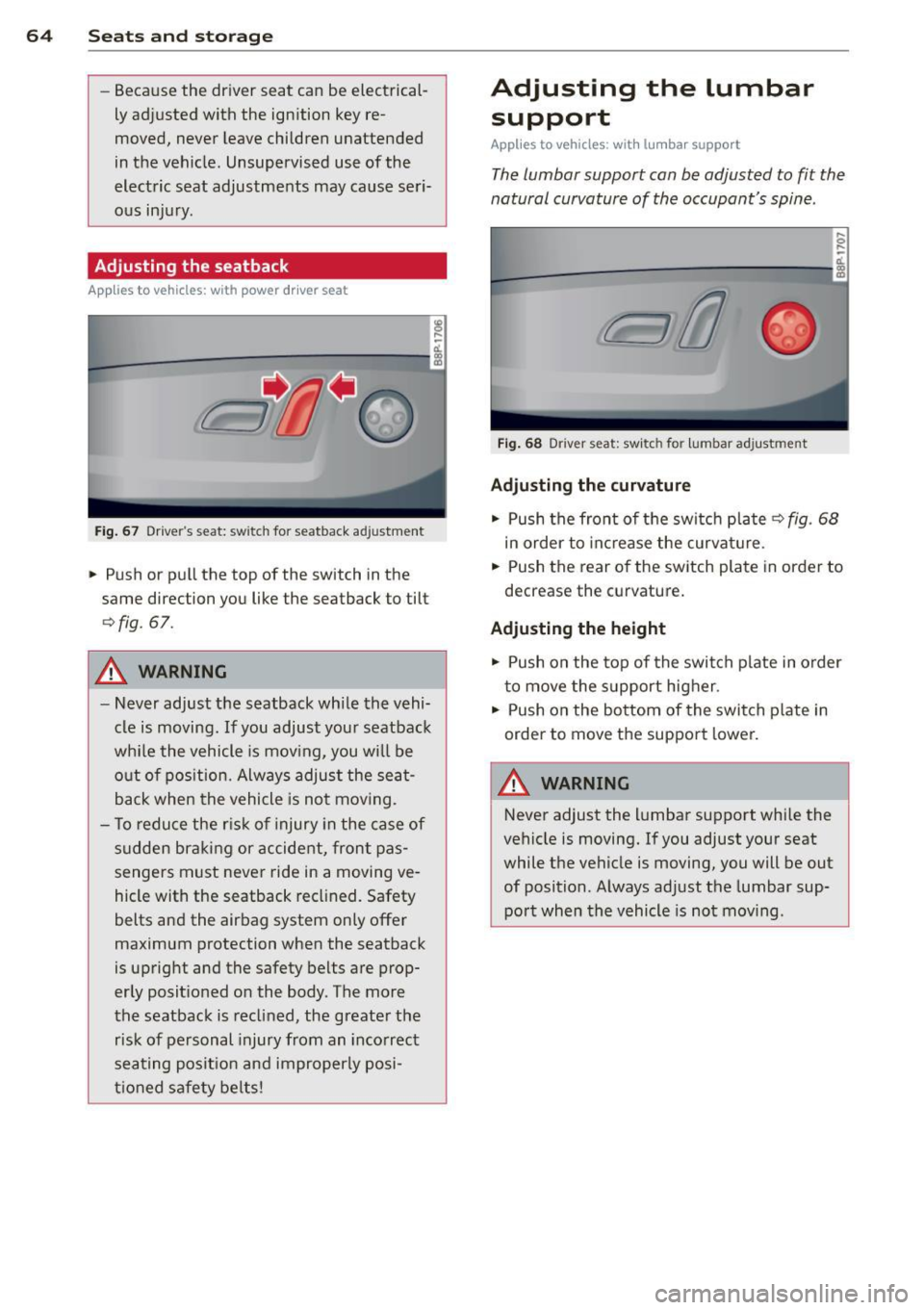
64 Seats and storage
-Beca use the driver seat can be electrical
ly ad justed with the ign ition key re
moved, never leave children unattended
in the vehicle . Unsupervised use of the
electric seat adjustments may cause seri o us in jury.
Adjusting the seatback
App lies to vehicles: with power driver seat
u-
Fig . 67 Drive r's seat: switc h for seatback adjustment
• Push or pull the top of the switch in the
same direction you like the seatback to tilt
¢fig. 67.
A WARNING
- Never adjust the seatback whi le the vehi
cle is moving. If you adjust your seatback
w hil e the vehicle is mov ing, you wi ll be
o ut of pos ition. Always adjust the seat
back when the vehicle is no t mov ing.
- T o redu ce the r is k of injury in the case of
sudden bra king or accident, front pas
sengers must never ride in a moving ve
hicle with the seatback reclined. Safety
belts and the airbag system only offe r
maximum protection when the seatback
is upright and the safety belts are prop
er ly posit ioned on the body . The more
the seatback is reclined, the greate r the
risk of personal injury from an incorrect
seating posit ion and improperly posi
tioned safety be lts!
Adjusting the lumbar
support
Applies to vehicles: with lumba r support
The lumbar support can be adjusted to fit the
natural curvature of the occupant's spine.
F ig . 68 Driver seat: switc h for lumbar ad justment
Ad justing the curv atur e
.,. Push the front of t he sw itch plate c:> fig . 68
in order to in cr ease the curva ture.
• Push the rear o f the switch plate in order to
decrease the curvature.
A dj usting the height
• Push on the top of the switch p late in order
t o move the s upport higher .
• Push on the bottom of the switch p late in
order to move t he support lower.
A WARNING
-
Never adjust the lumbar support while the
vehicle is moving. If you adjust your seat
while the vehicle is moving, you will be out
of position. Always adjust the lumbar sup
port when the vehicle is not mov ing .
Page 67 of 280
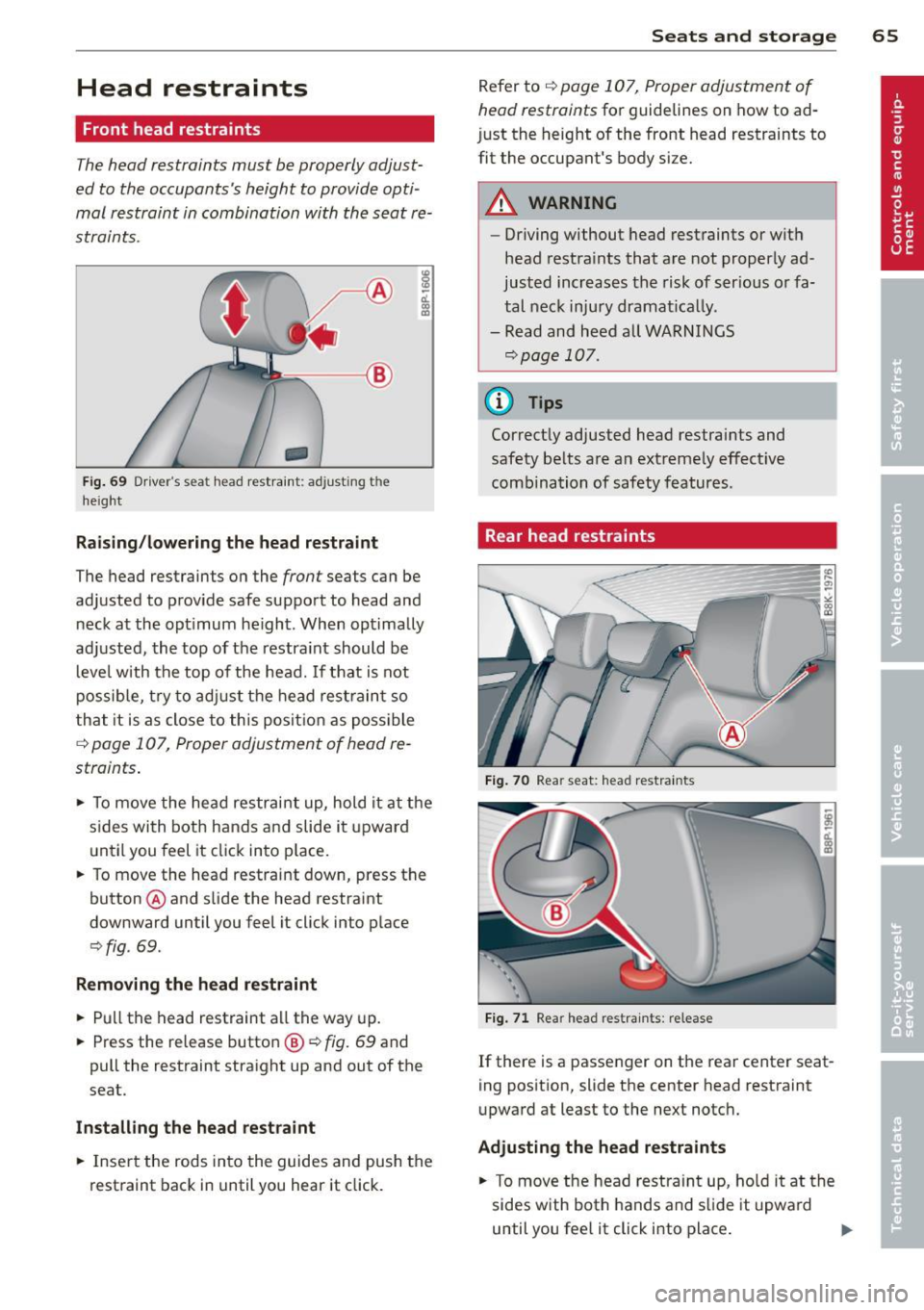
Head restraints
Front head restraints
The head restraints must be properly adjust
ed to the occupants's height to provide opti
mal restraint in combination with the seat re
straints.
Fi g. 69 Driver's s eat head restra int: ad just ing the
heigh t
Raising /lowering the head restraint
s
-d. a, a,
The head restraints on the front seats ca n be
adjusted to prov ide safe suppo rt to head and
neck at the opt imum he ight. When optimally
adj usted, the top of the restra int should be
L eve l w ith the top of the head. If that is not
possible, try to ad just the head restrain t so
that it is as close to th is pos it ion as poss ible
r:=> page 107, Proper adjustment of head re
straints .
.,. To move the head restrai nt up, hold it a t the
s ides with bot h hands a nd slide it upward
un til you feel it click into p lace .
.,. To move the head restraint dow n, press the
button @ and slide the head restraint
downward until you feel it click into p lace
r:=> fig . 69.
Removing the head re straint
.,. Pu ll the head restraint a ll the way up.
.,. Press the re lease butto n@
r:=> fig. 69 and
pull the restraint stra ight up and out of the
seat.
Install ing the head rest raint
.,. Inse rt the rods into the guides and push the
rest raint back in until you hear it click.
Seats and storage 65
Refer to r=> page 10 7 , Proper adjustment of
head restraints
for guidelines on how to ad
j ust the height of the front head restraints to
fit the occupant's body size.
A WARNING
- Driving without head restraints or wit h
head restra ints that a re not proper ly ad
justed increases the risk of ser ious or fa
tal nec k inju ry dramat ica lly.
- Read and heed all WARNI NGS
r:=>page 107 .
(D Tips
Correct ly adjusted head restrai nts and
safety be lts a re an e xtreme ly effect ive
combination of safety features.
Rear head restraints
Fi g. 7 0 Rea r seat: head restra ints
Fig. 7 1 Rear head res tra ints: release
If there is a passenger on the rear center seat
ing pos ition, slide the center head restraint
u pward at least to the next notch.
Adjusting the head restraints .,. To move t he head restra int up, ho ld it at the
sides with both hands and s lide it upwa rd
until you fee l it click into place .
Page 68 of 280
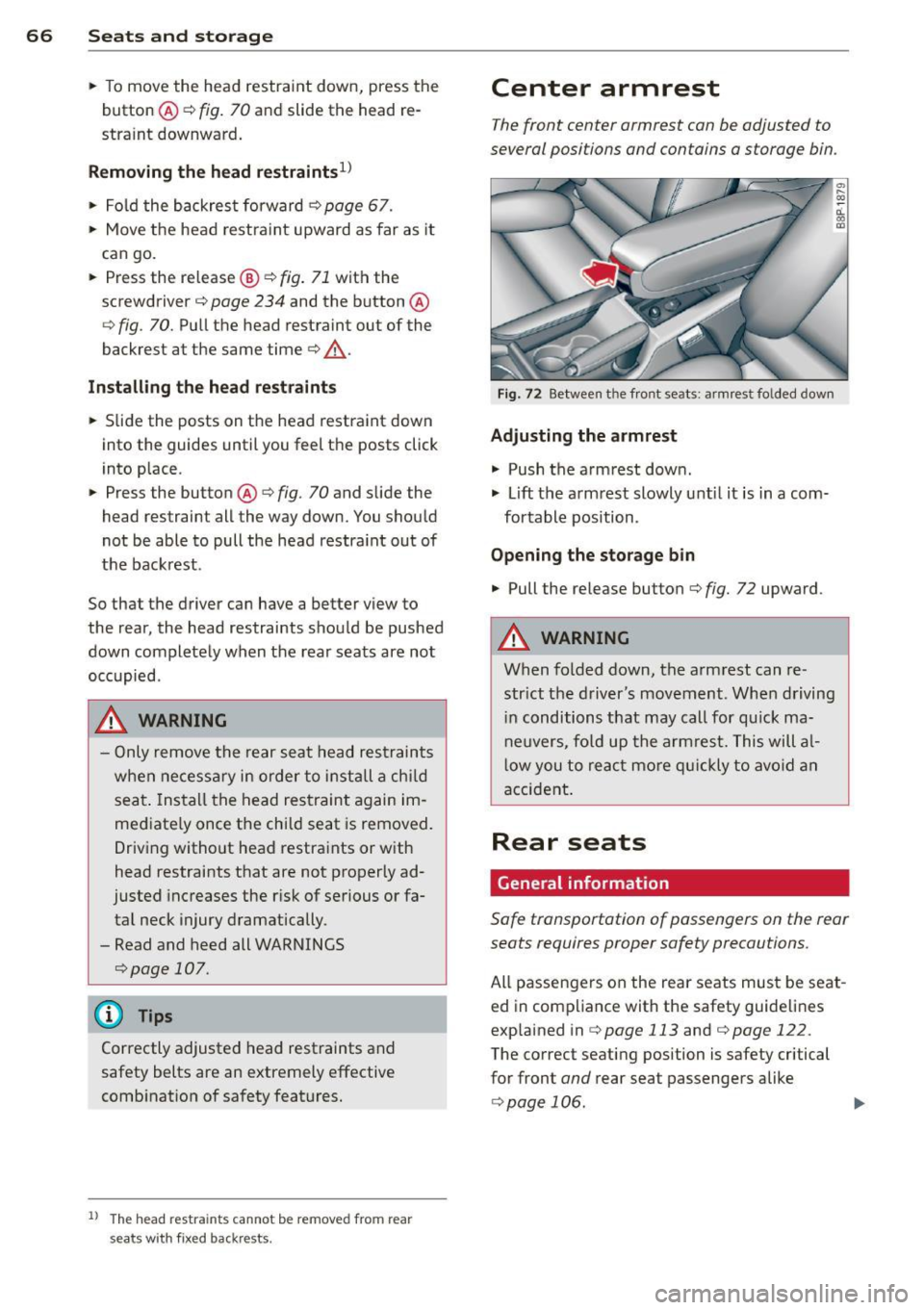
66 Seats and st o rage
• To move the head restraint down, press the
button @c>
fig. 70 and slide the head re
straint downward.
Removing the h ead restraint s
1>
• Fold the backrest forward ¢ page 67.
• Move the head restra int upward as far as it
can go.
• Press the re lease @ c>
fig. 71 with the
screwdriver¢
page 234 and the button @
¢fig. 70. Pull the head restraint out of the
backrest at the same time
c> &_.
Install ing th e head re st ra int s
• Slide the posts on the head restraint down
into the guides until you feel the posts click
into place.
• Press the button @¢
fig. 70 and slide the
head restraint all the way down. You should
not be able to pull the head restra int out of
the backrest.
So that the driver can have a better view to
the rear, the head restraints should be pushed
down completely when the rear seats are not
occ upied.
A WARNING
- Only remove the rear seat head res traints
when necessary in order to install a chi ld
seat . Install the head restraint again im
mediately once the child seat is removed.
Driving without head restraints or with
head restraints that are not properly ad
justed increases the r isk of serious or fa
tal neck injury dramatically.
- Read and heed all WARNINGS
¢page 107.
@ Tips
Correctly adjusted head restraints and
safety belts are an extremely effective combinat io n of safety features.
l) The head restraints cannot be removed from rear
seats with fixed backrests .
Center armrest
The front center armrest con be adjusted to
several positions and contains a storage bin.
F ig . 72 Between the front seats: armrest folded down
Adjusting the armrest
• Push the arm rest down.
• Lift the arm rest slowly unt il it is in a com
fortable position.
Opening the storage bin
• Pull the release button ¢
fig. 72 upward.
A WARNING
-
When folded down, the a rmrest can re
str ict the d river's movement. Whe n driving
i n conditions that may call for qu ick ma
neuvers, fo ld up the armrest. This will a l
l ow you to react more qu ickly to avoid an
accident .
Rear seats
General information
Safe transportation of passengers on the rear
seats requires proper safety precautions.
All passengers on the rear seats mus t be seat
ed in compliance with the safety guide lines
exp lained in
c> poge 113 and r=>poge 122.
The correct seating position is safety critical
for front
and rear seat passengers alike
r=> poge 106. .,,_
Page 69 of 280
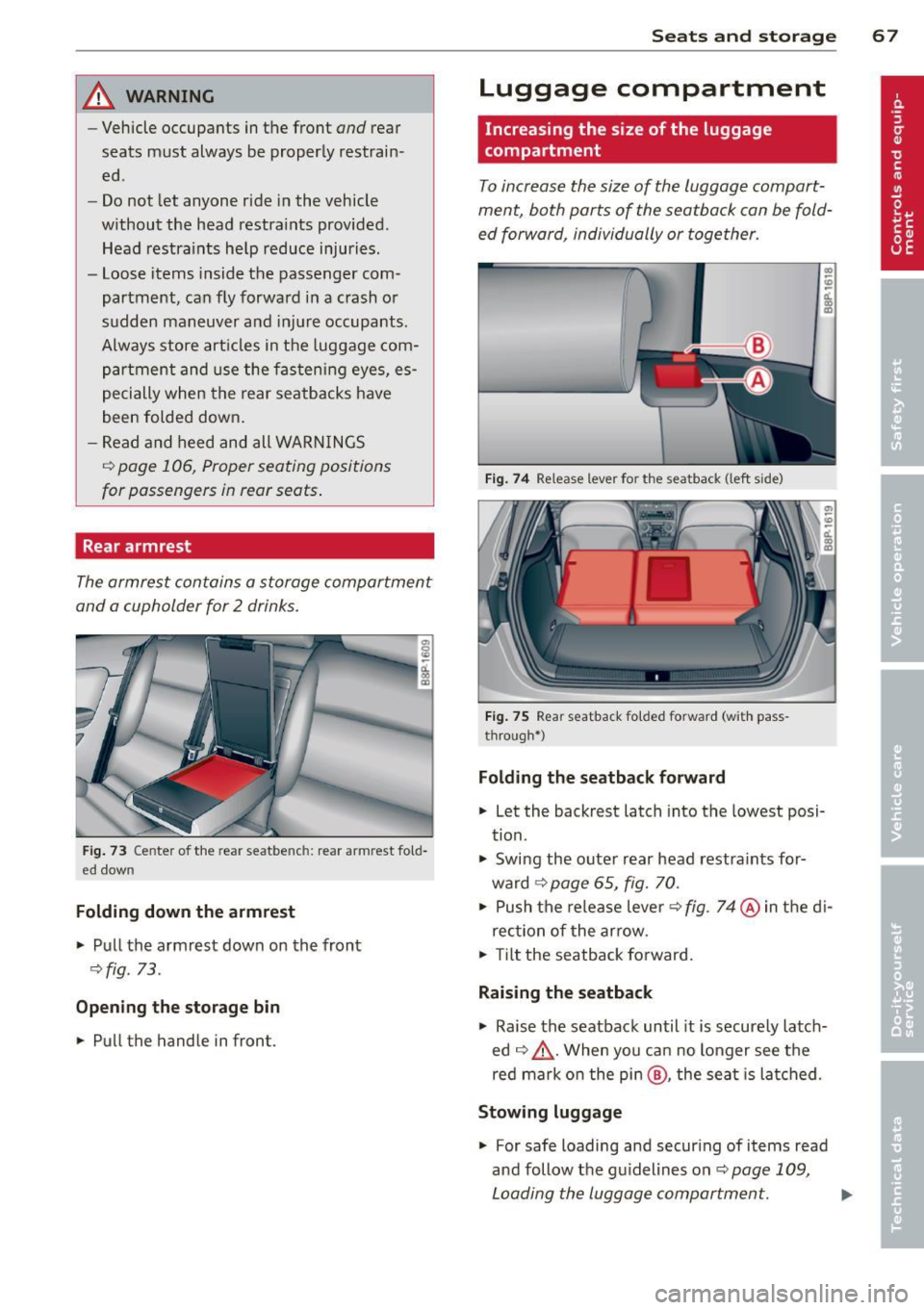
_& WARNING
-Vehicle occupants in the front and rear
seats must always be properly restrain
ed .
- Do not let anyone ride in the vehicle
without the head restra ints provided .
Head restraints help reduce injuries .
- Loose items inside the passenger com
partment, can fly forward in a crash or
sudden maneuver and injure occupants.
Always store articles in the luggage com
partment and use the fastening eyes, es
pecially when the rear seatbacks have
been folded down .
- Read and heed and all WARNINGS
r::';> page 106 , Proper seating positions
for passengers in rear seats .
Rear armrest
The armrest contains a storage compartment
and a cupholder for 2 drinks.
F ig . 73 Ce nter of the re ar s eatbe nch : rear armrest fo ld
e d dow n
Folding d own the armre st
.,. Pull the armrest down on the front
¢fig . 73 .
Opening the stor age bin
.,. Pull the handle in front.
Sea ts a nd s to rage 67
Luggage compartment
Increasing the size of the luggage
compartment
To increase the size of the luggage compart
ment, both parts of the seatback can be fold
ed forward, individually or together.
Fig . 7 4 Re lease leve r fo r th e seatbac k (left side)
Fig . 75 Re ar seatback fo lde d fo rw ar d (w it h pa ss
thro ugh• )
Folding th e seatb ack forward
.,. Let the backrest latch into the lowest posi
tion.
.,. Swing the outer rear head restra ints for
ward
¢ page 65, fig . 70 .
.,. Push the release lever¢ fig. 74 @ in the di-
rection of the arrow .
... Tilt the seatback forward.
Rai sing th e se atback
.,. Raise the seatback until it is secure ly latch
ed
c::> &,. . When you ca n no longer see the
red mark on the pin @, the seat is latched .
Stowing luggage
.,. For safe loading and secur ing of items read
and follow the gu idelines on
c::, page 109 ,
Loading the luggage compartment. ..,.
Page 70 of 280
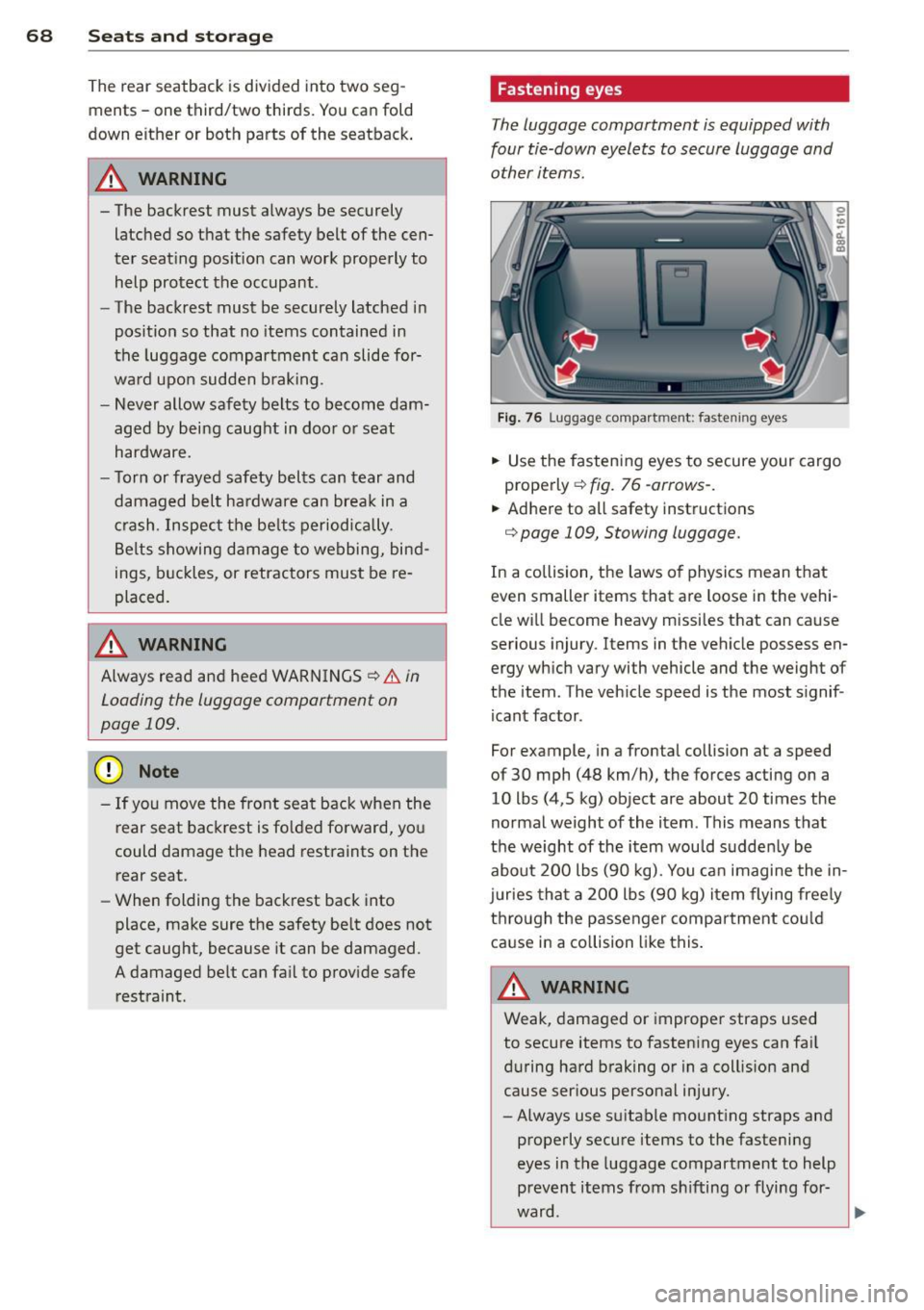
68 Seats and storage
The rear seatback is divided into two seg
ments - one third/two thirds. You can fold
down either or both parts of the seatback .
.&_ WARNING
-
- The backrest must always be securely
latched so that the safety belt of the cen
ter seat ing pos ition can work properly to
help protect the occupant .
- The backrest must be securely latched i n
posit ion so that no items containe .d in
the luggage compartment can slide for
wa rd upo n sudden b rak ing .
- Never allow safety belts to become dam
aged by being caught in doo r or seat
hardware.
- Torn or frayed safety belts can tear and
damaged belt ha rdware can brea k in a
c rash . Inspect the be lts periodica lly .
Belts showing damage to we bbing, bind
ings, b uckles, or retractors must be re
placed.
.&_ WARNING
Always read and heed WA RNINGS c:> .&. in
Loading the luggage comportment on
page 109.
(D Note
- If you move the fro nt seat back when the
r ear seat backrest is fo lded fo rward, yo u
could damage the head restraints on the rear seat.
- When folding the backrest back into
place, make sure the safety be lt does not
get caught, because it can be damaged.
A damaged be lt can fa il to prov ide safe
r est raint.
-
Fastening eyes
The luggage comportment is equipped with
four tie-down eyelets to secure luggage and
other items.
F ig. 7 6 Lugg age compart men t: fas tenin g ey es
.,. Use the fastening eyes to secure your cargo
properly
c:> fig. 76 - arrows -.
.,. Ad here to all safety instructions
<=> page 109, Stowing luggage.
In a co llision, t he laws o f physics mean that
even smaller items that a re loose in the vehi
cle w ill become heavy missiles that can cause
serious injury. Items in the vehicle possess en
ergy wh ich vary with vehicle and t he weight of
the item. The veh icle speed is the most s ignif
icant factor .
For example, in a frontal collision at a speed
of 30 mph (48 km/h), the forces acting on a 10 lbs (4,5 kg) object are about 20 times the
normal weight of the item . This means that
the weight of the item wou ld sudden ly be
about 2 00 lbs (90 kg). You ca n imagine the in
j u ries tha t a 200 lbs (90 kg) item flying free ly
t hr ough the passenger comp artment cou ld
ca use in a co llision like this .
_& WARNING
Weak, damaged or improper straps used
to secure items to fasten ing eyes can fai l
d uring hard braking or in a coll is ion and
cause ser ious personal injury. -
-A lways use s uitable mount ing straps an d
properly secure items to the fasteni ng
eyes in the luggage compartment to help
prevent items from sh ifting or flying for-
~~-~